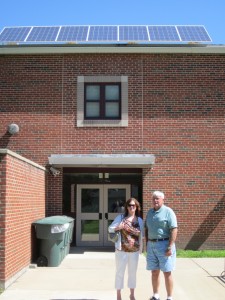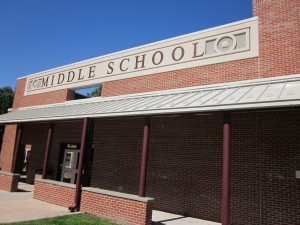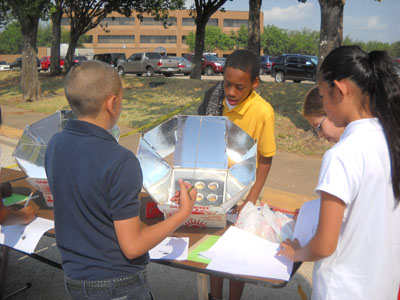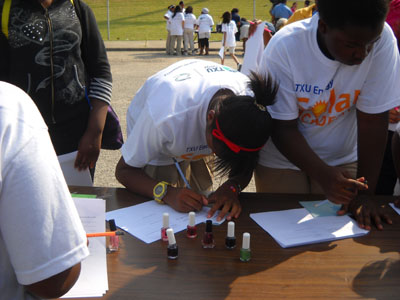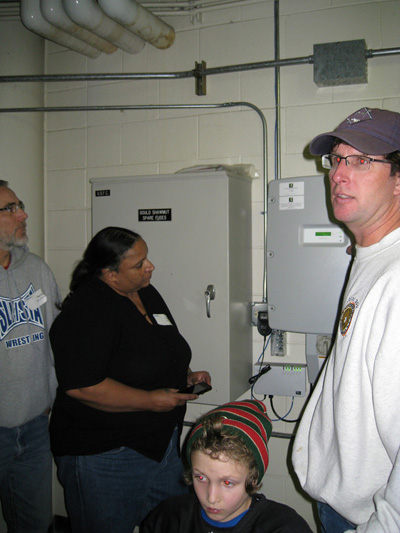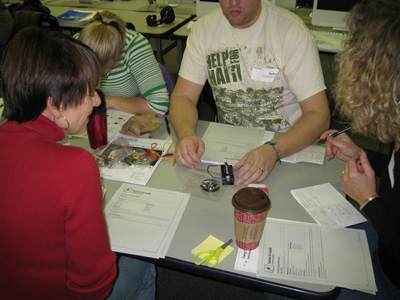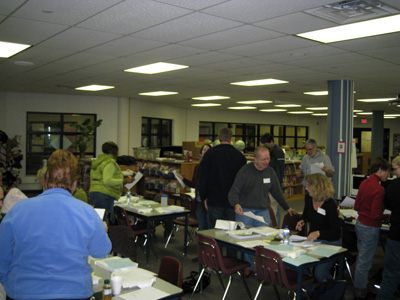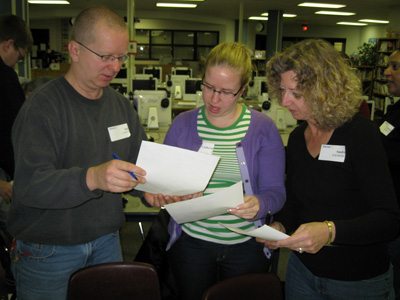Glen Kizer, of Energy Seeds and the Foundation for Environmental Education, recently had a chance to talk with author Sharon Gamson Danks about her new book about green schoolyards entitled, Asphalt to Ecosystems: Design Ideas for Schoolyard Transformation (New Village Press, Nov. 2010).
Glen Kizer: “Since schools have classrooms, why do you feel it is necessary or important to make the schoolyard part of the curriculum? Aren’t schoolyards for play and classrooms for education?”Â
Sharon Gamson Danks: Schoolyards are indeed places for play and indoor classrooms have been the usual learning environment for many years—but many schools are now seeing that their grounds can be useful to them in other ways, allowing them to do much more than simply toss a ball at recess. There is a growing global movement that approaches school grounds as a potential resource for learning, play, and ecology—envisioning schoolyards as places to develop a much wider variety of play options, while also enhancing hands-on lessons on many academic subjects, and improving the ecology of their site and the surrounding neighborhood.
Often referred to as “green schoolyards,†“ecological schoolyards,†or “sustainable schoolyards,†these enhanced grounds are being developed at schools that serve students of all ages, from preschool through high school. Their yards are as varied as their geographic locations and curricula, with each school adding teaching resources that meet the needs of their own faculty and students, and reflect the ecology and cultural context of their environment.
Successful green schoolyards can emerge from vastly different climates and sensibilities to include resources that combine ecological improvements with learning goals, including elements such as: organic gardens with fruit trees, vegetables, chickens, and outdoor cooking facilities; wilderness habitats with prairie grasses and ponds, or forest and desert ecosystems; schoolyard watershed models, rainwater catchment systems and waste-water treatment wetlands; renewable energy systems with photovoltaics or wind turbines; and waste-as-a-resource projects that give new life to old materials in beautiful ways. Schoolyards can also be fantastic places for messy art studios, outdoor music and drama performances, hands-on science and math lessons, language and social studies, geography and geology lessons, nutrition education, and other topics. Many schools also develop outdoor classroom spaces of various sizes so that teachers can use their enhanced grounds as effective teaching spaces.
At the preschool and elementary school levels, these enriched, naturalized spaces also provide wonderful, open-ended, imaginative play venues where children can dream up their own games among flowers, trees, and boulders, choose to play sports, or climb and swing, as they like. At all grade levels, green schoolyards can also provide comfortable environments with shade, clustered seating to encourage social gatherings, student artwork, and welcoming signage.
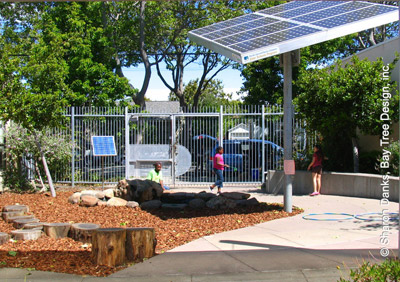
Rosa Parks Elementary
Glen Kizer: “Many schools are now working toward LEED and CHPS standards to green their buildings. How can this work be made more visible to students?â€
Sharon Gamson Danks: Meeting LEED, CHPS, and other environmental building standards often improves the environmental impact of school buildings—but it doesn’t automatically improve students’ understanding of their school site or the larger world. School buildings that meet these rigorous environmental standards but don’t explain the exemplary features of their finished building in a way that students can understand are missing out on a vital opportunity to pass an environmental stewardship ethic on to the next generation.
Designers of school buildings and grounds should make sure to include interesting, on-site, interpretive displays that are accessible to students and adults, and explain the purpose of the major environmental features of the building and grounds. These displays can be as simple as a “truth window†in a straw-bale wall or as complex as an electronic kiosk with real-time data updates. All displays should include some written text that explains the value of each improvement being showcased. The best interpretive displays allow students to gather and post their own data about their school site on a regular basis, involving them in tracking the performance of their own environment, and turning students into stewards of their place.
School designers should also seek to engage teachers and school administrators in a dialog about the environmental features of the completed school buildings so that they can support students’ interaction with their environment in the coming years—and become knowledgeable and efficient users of their green building and grounds. Since school communities of administrators, teachers, parents, and students change rapidly over time, each school with green design features would greatly benefit from an engagingly written final report about their building’s construction process and completed design features, written by their architecture and landscape architecture firms. This report should be compiled in non-technical language and include simple drawings or diagrams explaining the project, so that the school can keep it as part of their history. It will also become a resource for ongoing academic lessons related to the performance of their own school site.
Glen Kizer: “What are the range of energy systems you’ve seen on school grounds in your travels to schools around the world?â€Â
Sharon Gamson Danks: “For schools, energy is a topic that hits close to home. Schools are substantial consumers of energy, using electricity, natural gas and other sources of energy to heat, light, and power school facilities; and most of their inhabitants use fossil fuels to commute to school. Educating today’s students about renewable energy systems and energy conservation practices will help our communities make smarter decisions about tomorrow’s energy needs. Every school has access to sunlight, wind, and other forms of energy, but most are not yet using them as renewable energy resources or educational tools. School communities can engage their students in reducing their facility’s energy footprint, while teaching real life lessons about where energy comes from and what it takes to produce and transmit power. Students can also be encouraged to reduce their transportation-related energy usage by walking and biking to school.†(Sharon Danks, Asphalt to Ecosystems: Design Ideas for Schoolyard Transformation, p.63)
Schools around the world are using a variety of strategies to improve their facilities’ energy footprint. Energy conservation is one of the least expensive and most straight forward techniques, including a range of options such as: passive solar building design, increased insulation, student-led energy audits, natural lighting, and increased shade around the building’s exterior. Some schools engage other energy resources that are available to them such as the sun, wind, and constant ground temperature. I have seen schools that use: solar thermal systems to heat water; photovoltaic and wind-powered systems to produce electricity; and geothermal systems to pre-heat and pre-cool their incoming air and/or water, and reduce the energy required to run their building’s HVAC system. The best of these projects include interpretive displays that explain how the systems function, and help students to track the energy produced and used each day, over time.
Some of these energy systems are quite large, allowing a school to produce as much energy as it uses each year. Other energy projects are smaller, and include things such as a stand-alone solar panel that powers a pond pump system. While it is ecologically preferable to have an energy system that is substantial enough to reduce the building’s impact on the environment, energy systems at all scales can be useful demonstrations and teaching tools if combined with effective interpretive displays and curriculum ties.
In addition to their building and grounds-related energy systems, many schools have companion programs that encourage students to reduce their use of fossil fuels while they travel to and from school. Onsite bike racks and racks for skateboards and scooters help to encourage non-motorized transportation, as do “walking bus†programs, where students meet at a neighborhood location to walk to school together. Carpooling and public transportation are also often elements of fossil fuel reduction efforts for schools.
Sharon Gamson Danks is the author of Asphalt to Ecosystems: Design Ideas for Schoolyard Transformation (New Village Press, Nov. 2010) and an environmental planner and co-founder of Bay Tree Design, inc. in Berkeley, California.
To purchase a copy of this book from the non-profit publisher, please visit New Village Press.
For more information about Asphalt to Ecosystems and Sharon’s work, please see:
